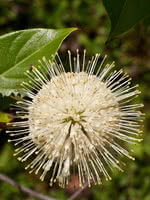Mon-Fri 9am - 5pm Mountain time
Black Elderberry vs Buttonbush
Sambucus canadensis
Cephalanthus occidentalis
NOT AVAILABLE THIS SEASON - MIGHT RETURN
CUSTOM GROW
Black Elderberry is a deciduous shrub native to eastern North America. You can plant this shrub in moist areas and it will help stabilize your soil. You can also use it on rural properties anywhere you'd use a lilac.
Black Elderberries are considered to be partially self-pollinating. So while they will still produce some berries without cross-pollination, planting with another variety will increase yields. Consider planting with Ranch Elderberry or Bob Gordon Elderberry.
Warning: the seeds, stems, leaves, roots, and uncooked berries of the Black Elderberry are poisonous to humans when eaten in quantity. You should cook the berries to make them safe for human consumption.
Buttonbush is a moisture loving shrub that provides year round interest.
It has round, fragrant flowers resembling small buttons or pincushions. The flowers transform into small reddish-brown fruit that persists into winter while the leaves take on shades of red in fall.
Providing essential food to bees, butterflies, and other insects, this shrub is versatile. Try it in your next shrub border.
Black Elderberry Quick Facts
Buttonbush Quick Facts
Toxicity: leaves, stems, and uncooked berries are poisonous to humans

